On Christmas Eve, Disney released their centennial animated celebration, Once Upon a Studio onto their YouTube channel. If you haven’t already seen this formerly Disney+ exclusive, check it out right here:

At minute 1:24, we see a short stack of books. The top of which looks to be a French copy of Pierre Lambert’s Bambi, as I am not aware of an English translation outside of Stuart Ng’s English Translation pamphlet. Below Bambi looks to be Lambert’s 1998 English hardcover translation of Mickey Mouse. And lastly, The Art of Walt Disney by Christopher Finch on the bottom – though it does look to be an earlier edition, as the spine was redesigned for the fourth edition and the recently released centennial fifth edition.
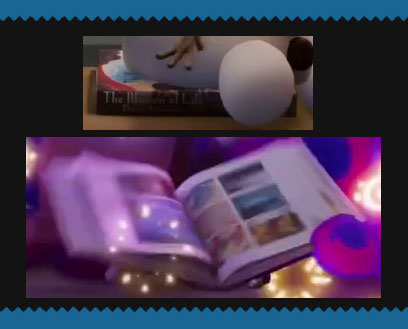
A notable scene at minute 2:56, in an unidentified animator’s office, finds Frozen’s Olaf perched upon a copy of Disney Animation: The Illusion of Life by Frank Thomas and Ollie Johnston. When Aladdin’s Genie unexpectedly explodes from Olaf’s drawing pad, the book is knocked open to what seems to be page 193, a page depicting a series of six artistic styles seen in the backgrounds throughout Bambi. However, my edition features that page on the left and, weirder still, the pictures seem vertically mirrored.
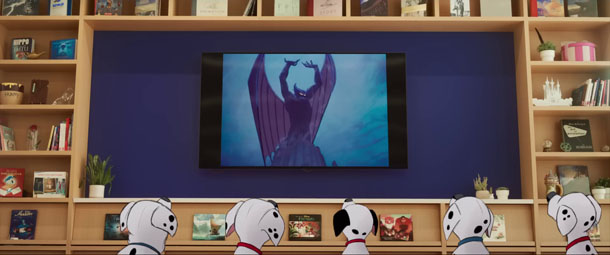
While the aforementioned scenes were a fine appetizer, the main meal of animation book cameos comes during the three and a half minute mark where the 101 Dalmatians are gathered around enjoying a viewing of Fantasia. Surrounding the flat screen television is a huge amount of “Art of…” and other significant historical books. Let’s start with the first four cubbies of the top shelf.

Paper Dreams: The Art & Artists of Disney Storyboards by John Canemaker starts off next to the first edition of David A. Bossert’s Oswald the Lucky Rabbit: The Search for the Lost Disney Cartoons. Cubby two features the revised Encyclopedia of Walt Disney’s Animated Characters: From Mickey Mouse to Hercules by John Grant and next to that a copy of A Wish Your Heart Makes: From the Grimm Brothers’ Aschenputtel to Disney’s Cinderella by Charles Solomon. The second title in the Walt Disney Animation Studios: The Archive Series, Animation sits besides a set of three books. Props to those who can identify them! In the last cubby is Mindy Johnson’s Tinker Bell: An Evolution and the first volume in the Walt Disney Animation Studios: The Archive Series, Story.

The second half of the top row consists of The Art of The Hunchback of Notre Dame by Stephen Rebello, The Walt Disney Family Museum exhibition guide, Snow White and the Seven Dwarfs: The Creation of a Classic by J.B. Kaufman. J.B. Kaufman also pens the first book in the second cubby, The Walt Disney Family Museum: The Man, The Magic, The Memories. Our fourth book featured is in a silver slipcase, Fantasia 2000: Visions of Hope by John Culhane. The last cubby on the top contains The Art of Hercules: The Chaos of Creation by Jane Healey and Stephen Rebello and The Art of The Lion King by Christopher Finch.
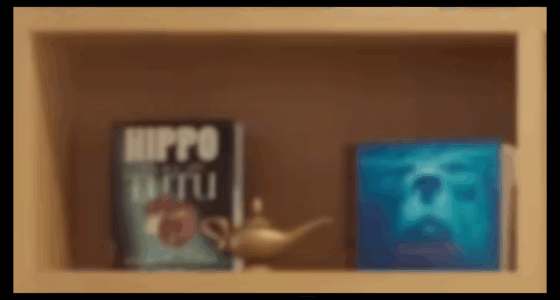
Below our first row on the left is Hippo in a Tutu: Dancing in Disney Animation by Mindy Aloff and Brother Bear: A Transformation Tale by Hiro Clark Wakabayashi. Staying on the left hand side of the television, but jumping down to the fourth row we find a shelf full of books, though they are a challenge to identify…

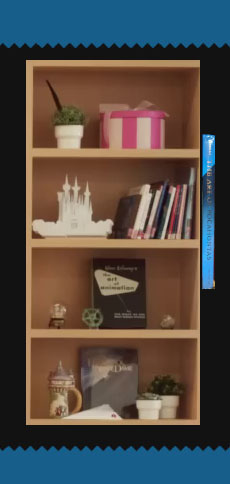
This is where a little bit of guesswork comes into play. It seems the second book from the left is The Art of Mulan by Jeff Kurtti. The fourth book facing us appears to be A Pig Named Perrier by Elizabeth Spurr. Jumping to the right, I think we see the spines of The Art of Inside Out next to an unidentified Art of… (?) book next to The Art of Wreck-It Ralph 2: Ralph Breaks the Internet by Jessica Julius. To the right of these art books we see the two volume set of Drawn to Life: 20 Golden Years of Disney Master Classes: The Walt Stanchfield Lectures. The last book I can identify is the red-spined Once Upon a Time: Walt Disney: The Sources of Inspiration for the Disney Studios by Bruno Girveau.
Jumping to the right side of the bookcase and looking to the second row, we see another spread of books. Unfortunately, I cannot seem to identify any of the books except the one on the far right appears to be the spine of The Art of Pocahontas by Stephen Rebello. Meanwhile, over on the third row – a ruse! As detailed by the D23 blog, this “book” was a prop used by Walt in the ABC TV show, Disneyland, in the episode “The Plausible Impossible”, that aired on October 31, 1956. On the final row we see for a second time, The Art of The Hunchback of Notre Dame by Stephen Rebello. Onto the bottom two rows we go!

The second from the bottom row consists of Charles Solomon’s The Art of Frozen. Next, The Art of Moana by Jessica Julius and Maggie Malone. Following that is The Art of Encanto. Jennifer Lee’s and Maggie Malone’s The Art of Wreck-It Ralph follows thereafter. Second to last is Winnie the Pooh: A Celebration of the Silly Old Bear by Christopher Finch. Lastly, The Art of Zootopia is by Jessica Julius.

The bottom row features Don Hahn’s The Alchemy of Animation: Making an Animated Film in the Modern Age. The first copy of Cody Maverick’s The Art of Meet the Robinsons on this shelf is the general release hardcover. The third book is The Nine Old Men: Lessons, Techniques, and Inspiration from Disney’s Great Animators by Andreas Deja. The second copy of Cody Maverick’s The Art of Meet the Robinsons is the Cast & Crew copy. The penultimate title in this row is the exhibition guide from the National Museum of China in Beijing from their 2016 exhibit, Drawn from Life: The Art of Disney Animation Studios. The last title featured in this shot is The Art of the Disney Princess.

Immediately after the 101 Dalmatians are warned of sitting too close to the television, the camera zooms in and reveals three additional titles on the left hand side, Walt Disney’s The Life of Donald Duck, Charles Solomon’s Disney Lost and Found: Exploring the Hidden Artwork from Never-Produced Animation, and John Culhane’s Disney’s Aladdin: The Making of an Animated Film.
That wraps what I could identify, it was a challenge to attempt to identify those two shelves of spined books. If only we had an 8K recording or more footage from behind the scenes. Additionally, there’s another pile of three books in the background of the Olaf/Genie scene that look deliberately pointed away from the camera. As you may have guessed, most of the books featured in the short were or are published by Disney or former Disney publishers. If you’re looking for a rudimentary list to get started on Disney animation, you would not go wrong starting with this set. You can check out these books and so many more on The Animation History Bibliography.
Bonus! This picture is from the 2022 live-action/CGI hybrid Chip ‘n Dale: Rescue Rangers, midway through the film we see Chip at his home with his other best friend…
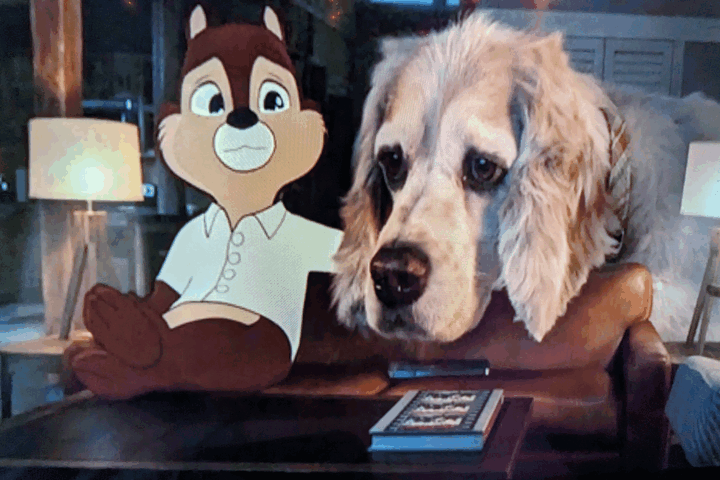
…with none other than John Canemaker’s Walt Disney’s Nine Old Men and the Art of Animation sitting on the coffee table. Until next time!


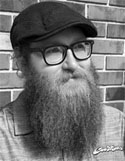 Orrin Scott is an animation researcher. His research focus has been on how society interacts with animation as a form of communication, commerce, art, and entertainment.
Orrin Scott is an animation researcher. His research focus has been on how society interacts with animation as a form of communication, commerce, art, and entertainment.








































Well done! It’s nice to know that I’m not the only one who likes to hit the pause button and obsess over background details. A lot of thought and care went into the placement of these books in the sets, and it deserves to be appreciated. The presence of all those animation books really underscores the studio’s artistic achievements of the past hundred years.
This discussion of books in the background of a Disney production reminds me of something that’s been puzzling me for about ten years now. In the Disney Channel sitcom “Dog with a Blog”, I recall seeing a closeup of the bookshelves in Bennett’s office (probably because Stan’s chew toy Robert was placed in a funny pose there). When I paused the shot, curious about Bennett’s taste in reading, I noticed that someone had painstakingly placed neatly cut pieces of opaque tape over certain words and letters in the book’s title and the author’s name. For example, if the book was THE HAUNTED ESPLANADE by ROBERT HUTCHINS, it might be taped over to read — -AUNT– —LANA– by –BERT HUTCH—. The spines of all the books visible on the shelf, dozens of them, had all been doctored in this way. Does anyone have any idea why Disney took the trouble to do this?
Granted, the “Art of ‘Inside Out’” book seems out of place for a short film devoted to honoring the Walt Disney Company’s foundational pillar studio. But when that’s the sole outlier, you otherwise can’t complain.
“Once Upon a Studio” is so meticulously crafted that any viewer can find a new layer of appreciation.
If there’s one thing Disney does better than any other production company since the advent of motion pictures, it’s self-congratulation.
I don’t know if anyone else has made this observation elsewhere on the net, but, stepping aside for the moment from the choice of literature depicted in the short, I thought it was an interesting historical inaccuracy that Mickey and Minnie seem to be stepping out of an identifiable scene from “Mickey’s Birthday Party” in the illustration depicted for the masthead of this article, and make the transition to new animation as smooth as silk – but the smoothness is accountable for, in that the scene they ate jumping out of is not an old animation cel at all, but a new piece of artwork made to look like it is from the old cartoon. How can you tell? Look at Mickey’s ears. Here, they are drawn in the traditional solid black and float around the head as in all the classic early cartoons, and the later cartoons of the ‘40’s. But “Birthday Party” was made during that experimental period when Mickey’s ears were being drawn somewhat in realistic perspective, visible at odd angles, and with slight variances of coloration to distinguish inner from outer ear. Why, then, would Disney studios open themselves to being caught on such an inconsistency by using “Birthday Party” as a starting point? An examination historically of Disney’s theatrical releases will tell the tale.
Someone seems to have made the tactical decision that they wanted to depict Mickey and Minnie in the new animation in their current classic stage of development, with modern outfits, flesh-tone faces, whites to their eyes, and solid black ears in non-perspective poses. This, however, was a near-impossible bill to fill when it came to finding a matching look from a classic animated short. Believe it or not, Mickey and Minnie only appeared together in the same shot in their modern design in three shorts produced pre-1953. “Mickey’s Delayed Date” would have presented a problem – when the two appear together, they are both wearing beat-up hobo-style outfits for a “Hard Times Party Dance”. Certainly not a wardrobe choice that would befit a 100th Anniversary. They have a cameo together in gay-90’s garb in “Crazy Over Daisy”, mimicking outfits they wore in “The Nifty Nineties” but without the perspective ears used in the former cartoon. But their cameo is extremely brief, and mostly seen with their faces turned away from the camera, as they wave a greeting to Donald passing on his high-wheel bicycle. This would only leave for a possible third starting point “Mickey’s Surprise Party”, a special short produced for Nabisco at the 1930’s New York World’s Fair, which didn’t receive a theatrical release, and didn’t again see the light of day until a VHS release, “The Spirit of Mickey”, and the “Mickey Mouse in Living Color v. 2″ Treasures tin in the DVD era. As such, shots from this film would be known only to a comparatively small number of devoted Disney fans, and a framed background from the film would yield no instant recognition of the work as from the classic past. Thus, the creators of “Studio” found themselves in a hole, with no way to compromise between the look they wanted for the characters and the classic shorts, except to ignore the inconsistency of Mickey’s and Minnie’s ear design, and start with a framed still on the wall that would look so close to a classic cel, no one would hopefully notice. Well, we noticed. But under the circumstances and limitations in number of Mickey and Minnie’s modern appearances together, one can say the fault is forgivable, and at least the reasons for the tactical choice made were well thought out.
On a video I just saw – a Leonard Maltin interview with the two directors (sent to Academy members to influence their support of the short for Oscar consideration) – they talk about their reasoning for using Mickey from Mickey’s Birthday Party. Partially it was because it was two director’s favorite period of Mickey Mouse shorts, that early 40s Riley Thompson era. I somewhat agree with the choice just based on that.
However there apparently was another reason. They wanted – in that key scene with Mickey looking up and “thanking” the portrait of Walt Disney – for Mickey to remove “his hat” and place it over his heart. (by the way, that scene, among many, was animated by Eric Goldberg). Yes, Mickey wears a hat in several films – including The Nifty Nineties and The Little Whirlwind from that period – but they reasoned that this particular hat would work best.
I’ve been in the Disney Animation building – and the choice of stills from the classic shorts on the wall there ARE pretty randomly chosen. An image from Mickey’s Birthday Party would not be out of place – and for the purposes of this 100th anniversary short, I think its quite appropriate.
I think the creative decision to utilize the Mickey’s Birthday Party version of Mickey worked the best in the scene where he is looking up at the portrait of Walt Disney. It does also demonstrate how much character attires can make or break the most important and even emotional moments in a scene and, like you indicated, Jerry, while on the topic of birthday celebrations paired with the 100th anniversary tipped the scale in Once Upon a Studio’s favor. Also, I think it goes without saying, but they couldn’t go wrong with Eric Goldberg animating such a poignant scene.
The one you said was The Art of Inside Out was actually an additional copy of The Art of The Princess and the Frog.
Also, there were other books in the animator’s office that I could find: Atlantis: The Lost Empire: The Illustrated Script, Treasure Planet: A Voyage of Discovery, and an additional copy of The Art of Pocahontas.
One of the books you said you’d give props to anyone who could identify them is The Art and Flair of Mary Blair, with the newer edition next to the books by The Art of Pocahontas. I myself have been trying to figure out the rest of the books, so I can gradually add them to my collection of animation books.
https://youtu.be/Mn3fwJP0uko?si=MVOznAZLUi_gm-2a If you’re interested, I have a video that goes over just about every book that appears in the short.